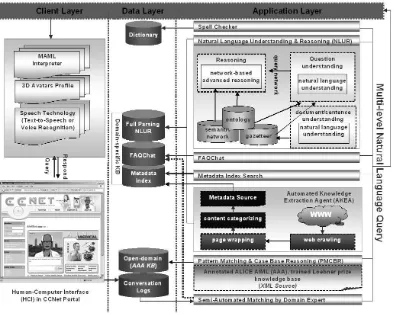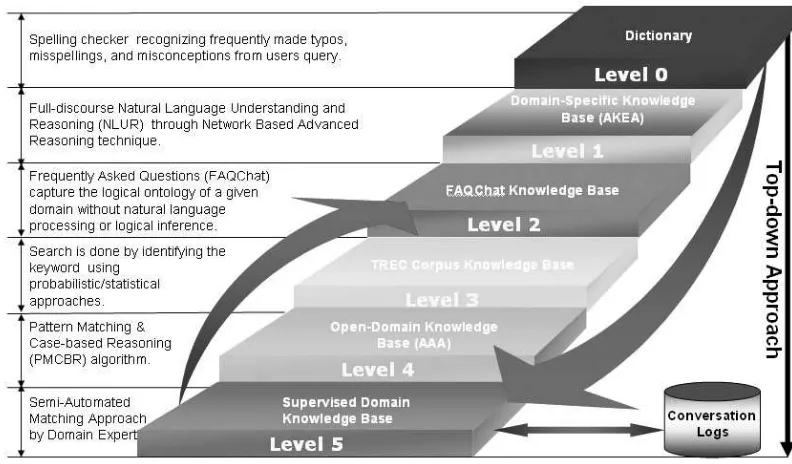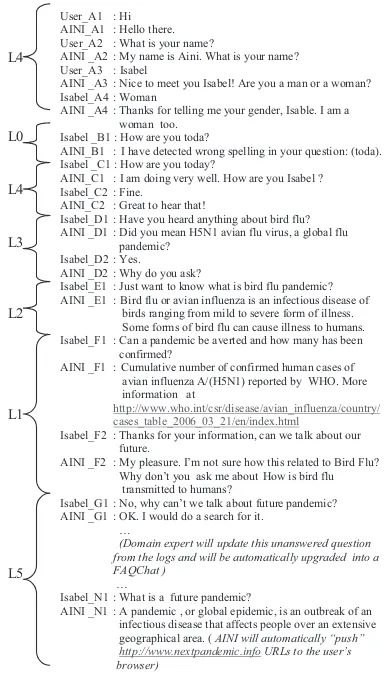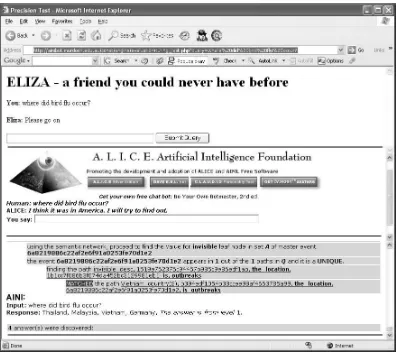Paper:
Embodied Conversational Agents for H5N1 Pandemic Crisis
Ong Sing Goh, Chun Che Fung, Kok Wai Wong, and Arnold Depickere
School of Information Technology, Division of Arts Murdoch University, Murdoch, Western Australia 6150 E-mail: os.goh, l.fung, k.wong, [email protected]
[Received April 20, 2006; accepted September 6, 2006]
This paper presents a novel framework for modeling embodied conversational agent for crisis communica-tion focusing on the H5N1 pandemic crisis. Our sys-tem aims to cope with the most challenging issue on the maintenance of an engaging while convincing con-versation. What primarily distinguishes our system from other conversational agent systems is that the human-computer conversation takes place within the context of H5N1 pandemic crisis. A Crisis Commu-nication Network, called CCNet, is established based on a novel algorithm incorporating natural language query and embodied conversation agent simultane-ously. Another significant contribution of our work is the development of a Automated Knowledge Extrac-tion Agent (AKEA) to capitalize on the tremendous amount of data that is now available online to support our experiments. What makes our system differs from typical conversational agents is the attempt to move away from strictly task-oriented dialogue.
Keywords: Natural Language Processing Understanding and Reasoning (NLUR), Artificial Intelligence (AI), Em-bodied Conversational Agent (ECA), H5N1 Bird Flu
1. Introduction
The ability of computers to converse with users in nat-ural language would arguably increase their usefulness and flexibility. Research in practical dialogue systems has matured tremendously in recent years [1, 2]. Today’s dialogue systems typically focus on helping users com-plete a specific task, such as information search, plan-ning, event management, or diagnosis. Recent advances in Natural Language Processing (NLP) and Artificial In-telligence (AI) in general have approached this idea to the point where such systems begin to appear in reality. It has been speculated by several known futurists that comput-ers will reach capabilities comparable to human reasoning and understanding of languages by the year 2020 [3].
Due to the complexity of natural language informa-tion and the open-domain nature of the World Wide Web, these modern-day question-answering systems have re-lied on techniques based on keywords and pattern match-ing. Such systems however have their drawbacks. In
ad-dition, many people would also like to create an applica-tion of personal natural language conversaapplica-tion agent on specialized interest with unique personalities. This will enable the user to interact with them on the web in a per-sonal way. This project is therefore intended to fulfill this objectives and the ongoing development is reported in this paper.
2. AINI’s Conversational Agent Architecture
This research project involves the establishment of a
Crisis Communication Network (CCNet) portal1. The
ob-jective is to use an embodied conversational agent based on an architecture called Artificial Intelligent Neural-network Identity (AINI) [4]. Our real-time prototype re-lies on distributed agent architecture designed specifically for the Web. The software agent is based on a conversa-tion engine using a multi-domain knowledge model and with multimodal human-computer communication
inter-face. It also offers multilevel natural language query
which communicates with one another via TCP/IP. In short, AINI or AINIBot is a conversation agent or chat-terbot designed by the authors that is capable of having a meaningful conversation with the users. From another perspective, AINIBot can be considered as a software conversation robot. It uses a form of human-computer communication system which is a combination of nat-ural language processing and multimodal communica-tion. A human user can communicate with the devel-oped system using typed natural language conversation. The embodied conversation agent system will reply text-prompts or Text-to-Speech Synthesis together with appro-priate facial-expressions.
For the purposes of this research, the application area chosen for designing the conversation agent is primar-ily within the context of pandemic crisis, Bird Flu using scripting and incorporation of artificial intelligence.
As illustrated inFig. 1, AINIBot adopts a hybrid
ar-chitecture that combines multi-domain knowledge bases, multimodal interface and multilevel natural language query. Given a question, AINIBot first performs question analysis by extracting pertinent information to be used in query formulation, such as Noun Phrases and Verb Phrases. AINIBot employs an Internet three-tier,
Embodied Conversational Agents for H5N1 Pandemic Crisis
Fig. 1. AINIBot’s architecture in the CCNet portal.
client architecture that may be configured to work with any web application. It comprises of a data server, appli-cation and client layers. This Internet specific architecture offers a flexible solution to the unique implementation re-quirements of the AINIBot system.
2.1. Data Layer
The data server layer serves as storage for permanent data required by the system, where the pandemic knowl-edge bases are stored. These databases are Dictionary, Domain-Specific, Open Domain and conversation logs.
The Dictionary isispellwhich was first ran on TOPS-20
systems at MIT-AI lab2. Domain-Specific database is
ex-tracted by the Automated Knowledge Extraction Agent (AKEA) which consists of Full Parsing NLUR, FAQChat and Metadata Index. The development of AKEA has been reported in [5] which was designed to establish the knowl-edge base for a global crisis communication system called CCNet. CCNet was proposed during the height of the SARS epidemic in 2003. As reported in [6], the AINIBot architecture is portable. It can be scaled up and port to any new application domain such as Bird Flu pandemic in the absence of principle approach.
The Open-Domain database is taken from the existing award winner from the Turing Test. This trained Knowl-edge Base is also called Annotated ALICE Artificial
In-2. http://www.mit.edu/afs/sipb/project/sipb-athena/src/ispell/
telligence Markup Language (AAA) [7] where the con-versation logs reside. These web-enabled databases are accessible via the SQL query standard for database con-nectivity using MySQL database.
2.2. Application Layer
The application server layer handles the processing of logic and information requests. Here, one or more ap-plication servers are configured to compute the dialogue logic through the multilevel natural language query algo-rithm as reported in [8]. In this layer we simulated goal-driven or top-down natural language query (NL-Query)
approach as humans process their language. Humans
examine a sentence or phrase as whole and if they do not recognize it, they will break it down into its com-ponent parts until they can recognize the parts of speech (POS). Recently in the field of AI, researchers are debat-ing whether bottom-up or top-down approach can be best used to model human brain. Mentalese or ‘language of thought’ and conceptual representation support the ideas of a top-down approach [9]. However in robotic, the MIT Cog Robot Team fervently supports the bottom-up ap-proach when modeling the human brain [10]. Top-down approaches are more often found in generation schemas [11], rhetorical structure theory [12] and plan-based
ap-proaches [13]. These are examples of top-down
Fig. 2. Top-down natural language query approach.
The top-down approach seems to be a good model to explain how humans use their knowledge in conversation. After much literature search, we believed that in the field of NLP, it seems that the top-down approach is by far the best approach. Therefore, we use top-down approach as
our NL-Query. As shown in the Fig. 2, our top-down
NL-query approach consists of 6 level of queries, namely Spell Checker (Level 0), Full-discourse NLUR (Level 1), FAQChat (Level 2), Metadata Index Search (Level 3), PMCBR (Level 4) and Semi-Automated Matching Ap-proach (Level 5).
2.3. Client Layer
The user interface resides in the thin-client layer and is completely browser based which employs Multimodal Agent Markup Language (MAML) interpreter or Mi-crosoft SAPI to handle the users interface. MAML is a prototype multimodal markup language based on XML that enables animated presentation agents or avatars. It involves a talking virtual lifelike 3D agent character that is capable of involvement in a fairly meaningful conversa-tion. The conversation engine is Web-based and is imple-mented by open-source architecture employing PHP, Perl scripting language and Apache Server. The knowledge base of the system is stored in a MySQL server.
3. NL-Query for H5N1 Conversational Agent
System
The AINIBot domain knowledge model usually incor-porates several knowledge domains. This is similar to the merging of expertise and knowledge from one or more experts. A “sales” domain knowledge for instance, would contain expertise on improving sales, but it would also
incorporate with an Open-Domain knowledge. Multiple domain knowledge, merged into the AINIBot’s single do-main knowledge would give the users a meaningful con-versation.
In this paper, Bird Flu pandemic is our Domain-Specific research focus. This is because, H5N1 pandemic has become increasingly important to demonstrate this re-search in real-world applications. According to the Wall Street Journal Online [14], this pandemic could be worse than that relatively mild one, and even worse than the deadliest of the past century, in 1918, which killed at least 20 million people at a time when the world had a smaller population which traveled less. In addition, the World Health Organization estimates the H5N1 virus could in-fect up to 30 percent of the world’s population. Shigeru Omi, the WHO official who issued a warning, said that estimates of 2-7 million deaths were “conservative” and that the maximum range could go as high as 50 million deaths [15].
We pre-defined the Open-Domain and Domain-Specific in the data layer. Based on the type of input provided by the user, the agent’s response state moves smoothly from one domain knowledge base and
NL-query Level to another respectively as shown in theFig. 2.
According to K. Mori et al. [16], these two intermediate states transition called “Reluctant” and “Concede”.
Even though the conversation agent allows the user to carry the conversation beyond their domain knowledge, however the conversational agent will continue to remind and recall the user by bringing back to the current topic
of the presentation. This is to convey and direct the
pre-Embodied Conversational Agents for H5N1 Pandemic Crisis
User_A1 : Hi AINI_A1 : Hello there. User_A2 : What is your name?
AINI_B1 :I have detected wrong spelling in your question: (toda). Isabel _C1 : How are you today?
AINI_C1 : I am doing very well. How are you Isabel ? Isabel_C2 : Fine.
AINI_C2 : Great to hear that!
Isabel_D1 : Have you heard anything about bird flu? AINI _D1 : Did you mean H5N1 avian flu virus, a global flu pandemic?
Isabel_D2 : Yes. AINI _D2 : Why do you ask?
Isabel_E1 : Just want to know what is bird flu pandemic? AINI _E1 :Bird flu or avian influenza is an infectious disease of birds ranging from mild to severe form of illness. Some forms of bird flu can cause illness to humans. Isabel_F1 : Can a pandemic be averted and how many has been confirmed?
AINI _F1 :Cumulative number of confirmed human cases of avian influenza A/(H5N1) reported by WHO. More information at
http://www.who.int/csr/disease/avian_influenza/country/ cases_table_2006_03_21/en/index.html
Isabel_F2 : Thanks for your information, can we talk about our future.
AINI _F2 : My pleasure. I’m not sure how this related to Bird Flu? Why don’t you ask me aboutHow is bird flu transmitted to humans?
Isabel_G1 : No, why can’t we talk about future pandemic? AINI _G1 : OK. I would do a search for it.
…
(Domain expert will update this unanswered question from the logs and will be automatically upgraded into a FAQChat )
…
Isabel_N1 : What is a future pandemic?
AINI _N1 : A pandemic , or global epidemic, is an outbreak of an
Fig. 3. Conversation logs on H5N1 pandemic by AINIBot.
sentation. An example of interaction domain knowledge model and NL-Query conversation between Isabel and
AINIBot on the bird flu pandemic is shown inFig. 3.
3.1. Experimental Setup
In our experiment, we used three chatterbots, ELIZ-ABot, ALICEBot and AINIBot. ELIZABot is the best known Artificial Intelligence program in the world. It is also one of the oldest. Created in the early 1960’s by MIT scientist Joseph Weizenbaum [17] and named after Eliza Doolittle, its mission was to attempt to replicate the conversation between a psychoanalyst and a patient. AL-ICEBot [18] was general conversation robot which was an off-the-shelf ALICE ProgramD chatterbot loaded with the Annotated ALICE Artificial Intelligence Markup Lan-guage (AAA) rule set consisting of knowledge base of approximately 46,424 categories that can be freely ob-tained from www.alicebot.org. Each of the knowledge categories consists of a pattern to match against the user’s input and a template response corresponding to the pat-tern. ALICEBot wons three times Turing Test [7]. How-ever AINIBot, was essentially identical to ALICEBot ex-cept that the knowledge base has been enhanced with Pen-demic Domain-specific knowledge base which was ex-tracted using AKEA and parsing with full Natural
Lan-guage Understanding engine.
We have designed a Response Satisfaction metric for this experiment. Response Satisfaction is measured for each user input/response pair on a Likert scale of one to seven. This measure is then aggregated for each chatter-bot and is therefore the summation of all Response Satis-faction scores for the chatterbot divided by the total num-ber of user inputs.
In this control experiment, domain responses are ex-pected to be more effective than dialog. The control
di-alog set question was given as shown inFig. 3. The
Re-sponse Satisfaction measures of the ELIZABot, ALICE-Bot and AINIALICE-Bot are broken down into constituent dialog and domain knowledge responses and calculated against one another. The control dialog question set was
submit-ted to the three difference URLs3where the three
chatter-bot engines was reside. The responses of the queries are displayed in three frames in the single windows interface
as shown inFig. 4.
3.2. Results from Selected Conversation Logs in H5N1
As shown in Fig. 4, given the question “Where did
bird flu occur?,” ELIZABot will response“Please go on.”
which is an incorrect answer generated randomly from ELIZABot knowledge base. This answer tries to encour-age the user to continue with the conversation. For the ALICEBot, instead of giving a random answer, ‘she’ tries to convince the user by guessing the question from the
wh-question “where” token. Therefore, ALICEBot
gener-ates an uncertain answer“I think it was in America. I will
try to find out.” However for AINIBot, the response was
“Thailand, Malaysia, Vietnam, Germany”which is gen-erated from the Domain-specific knowledge base using Natural Language Understanding parsing from the Level 1. In this query, four answers were discovered by
AINI-Bot which they come from difference sources4extracted
from AKEA. In our observation, ELIZABot and ALICE-Bot are unable to answer domain-specific question. But this is not the case with AINIBot. The full control dialog
test set generated by AINIBot is shown inFig. 3.
From this AINIBot conversation logs, the transition states in dialog pair A1-A4 and C1-C2 used Open-Domain from the NL-Query Level 4 where pattern match-ing and case base reasonmatch-ing (PMCBR) approach has been carried out. In the dialog pair B1, the NL-query
can-not proceed because the system found an error. The
word “today” was misspelled as [toda] which has been highlighted in the response. In the dialog pair D1-D2, NL-Query Level 3 has been imposed where the search done by identifying the keyword or phrase using prob-abilistic or statistical approaches from the metadata in-dex. In the dialog pair E1, FAQChat approach captured
Fig. 4. Experimental design interface.
the logical ontology of a given domain. In this Level 2, FAQChat is constrained to reply with the given Answers without NL generation to recreate well formed answers. However in dialog pair F1-F2, full-discourse NLUR through Network Based Advanced Reasoning technique with Domain-specific has been used. In the dialog pair, G1 shows that the AINIBot is unable to answer user ques-tion but she will forward the random statement such as
“I would do a search for it.”, “Did I misunderstand your meaning?”, “That’s an interesting question.”, “I’ll come back to that in a minute” etc. and these statements will be monitored and submitted into the unanswered conver-sation logs data layer. In this Level 5, domain expert will be responsible to pick up the proper matching result from a list of possible matches. Finally, the newly generated matching rules subsequently will be stored and upgraded into the Domain-specific knowledge set. Another signifi-cant result shows that in the dialog pair G2, the user had control of the conversation although the agent reminded the user of the topic of the current presentation in the dia-log pair F2. In addition, in the Level 5, the domain expert can also integrate the answer with relevance source from the internet using the “URL Push” technique. This will make the conversation more interesting and the informa-tion forwarded to the user is up-to-date.
4. Discussion and Conclusion
Despite all the advances in Internet, search technology and dialog system, it is still difficult for appropriate an-swers to be provided. AINIBot strives to be an effective means to provide answers from the Internet.
In this experiment we may conclude that the use of a chatterbot as a knowledge acquisition tool appears to be a reliable instrument in gathering both conversation and domain-related knowledge. In addition, natural language dialog systems AINIBot in particular, shows a promis-ing future in domain-restricted areas. Although we stud-ied only one particular area of domain expertise in pan-demic Bird flu, it would be useful to further pursue other domains. We also need to test the flexibility of AINI-Bot system as well. Furthermore, we found that domain-specific knowledge acquisition has higher Response Satis-faction levels than the corresponding conversational-style responses. This is regardless of the chatterbot being in-volved.
Embodied Conversational Agents for H5N1 Pandemic Crisis
the top-down NL-query approach shows more natural and appropriate behavior. In this paper, we only worked on selected pandemic crisis websites where we performed knowledge extraction for Domain-Specific databases on the server. Although we simulated the proxy conversation log, it is expected that new results from other conversation sessions will be different from the results referred in this paper.
Acknowledgements
This research was supported by a Murdoch University Research Excellence Grant Scheme (REGS), 2006. Funding for this publi-cation was granted by Division of Arts, Murdoch University.
References:
[1] J. Allen, D. Byron, M. Dzikovska, G. Ferguson, L. Galescu, and A. Stent, “Towards conversational human-computer interaction,” AI Magazine, Vol.22, 2001.
[2] J. Cassell, “Embodied Conversation: Integrating Face and Gesture into Automatic Spoken Dialogue Systems,” in Spoken Dialogue Systems, Luperfoy (Ed.), MIT Press, to appear.
[3] R. J. Lempert, S. W. Popper, and S. C. Bankes, “Shaping the next one hundred years: new methods for quantitative, long-term policy analysis,” Santa Monica, CA.: RAND, 2003.
[4] O. S. Goh, C. C. Fung, and M. P. Lee, “Intelligent Agents for an Internet-based Global Crisis Communication System,” Journal of Technology Management and Entrepreneurship, Vol.2, pp. 65-78, 2005.
[5] O. S. Goh and C. C. Fung, “Automated Knowledge Extraction from Internet for a Crisis Communication Portal,” in First International Conference on Natural Computation, Changsha, China: Lecture Notes in Computer Science (LNCS), pp. 1226-1235, 2005. [6] O. S. Goh, C. Ardil, W. Wong, and C. C. Fung, “A Black-box
Ap-proach for Response Quality Evaluation Conversational Agent Sys-tem,” International Journal of Computational Intelligence, Vol.3, pp. 195-203, 2006.
[7] H. Loebner, Loebner Prize Gold Medal, 2006 [Online]. Available: http://www.loebner.net/Prizef/loebner-prize.html
[8] O. S. Goh, A. Depickere, C. C. Fung, and K. W. Wong, “Top-down Natural Language Query Approach for Embodied Conversational Agent,” presented at the International MultiConference of Engi-neers and Computer Scientists 2006, Hong Kong, 2006.
[9] J. A. Fodor, “Elm and the Expert: An Introduction to Mentalese and Its Semantics,” Cambridge University Press, 1994.
[10] R. A. Brooks, “The Cog Project: Building a Humanoid Robot,” presented at The 1st International Conference on Humanoid Robots and Human friendly Robots, Tsukuba, Japan, 1998.
[11] K. R. McKeown, “Text Generation,” Cambridge University Press, 1995.
[12] J. D. Moore and C. L. Paris, “Planning text for advisory dialogues: Capturing intentional and rhetorical information,” Computational Linguistics, Vol.19, pp. 651-695, 1992.
[13] E. Reiter and R. Dale, “Building Natural Language Generation Sys-tems,” Cambridge University Press, 2000.
[14] C. Bialik, “Just How Deadly Is Bird Flu? It Depends on Whom You Ask,” January 13, 2005 [Online].Available: http://online.wsj.com/ public/article/SB110512998255120225.html?mod=todays free feature
[15] S. Lovgren, “Is Asian Bird Flu the Next Pandemic?,” December 7, 2004 [Online]. Available:
http://news.nationalgeographic.com/news/2004/12/1207 041207 birdflu.html
[16] K. Mori, A. Jatowt, and M. Ishizuka, “Enhancing Conversational Flexibility in Multimodal Interactions with Embodied Lifelike Agents,” presented at International Conference on Intelligent User Interfaces, Miami, Florida, USA, 2003.
[17] J. Weizenbaum, “ELIZA – A computer program for the study of natural language communication between man and machine,” Com-munications of the ACM, Vol.9, pp. 36-45, 1966.
[18] Alice, “Artificial Linguistic Internet Computer Entity,” 2005 [On-line]. Available: http://www.alicebot.org
Name:
Ong Sing Goh
Affiliation:
Associate Professor, Faculty of Information Technology and Communication, National Tech-nical College University of Malaysia
Address:
Melaka, 75250 Melaka
Brief Biographical History:
2000- Chairman for Centre of Excellence for Computer Languages, Multimedia University, Malaysia
2002- Director of University Press, and Chairman of the Center for Artificial Intelligence and Modeling, National Technical College University of Malaysia
2005- Honorable member of the Centre for Enterprise Collaboration in Innovative Systems (CECIS), Murdoch University, Perth Western Australia 2006- Research Assistant Director, IDLab (Intelligent Digital Lab), Murdoch University, Perth Western Australia
Main Works:
¯Best Paper Award, International MultiConference of Engineers and Computer Scientists 2006, pp. 27-29, Hong Kong, June, 2006.
¯Japan Institute of Invention and Innovation (JIII) Award for Best Individual Inventor, JIII International Awards, ITEX’04, Mid Valley, Kuala Lumpur, May 20-22, 2004.
¯Gold Medal, MINDS Awards, ITEX’04, Mid Valley, Kuala Lumpur, May 20-22, 2004.
¯1st Malaysian Robotic Interactive Programme, Malaysia Book of Records, Seri Negeri, Melaka, December 4, 2003.
Membership in Academic Societies:
¯Member of IEEE Computer Society
¯Member of Malaysia Invention and Design Society (MINDS) ¯Scientific Member of World Enformatika Society
Name:
Chun Che Fung
Affiliation:
Associate Professor, School of Information Technology, Murdoch University
Address:
South Street, Murdoch, Western Australia, Australia 6150
Brief Biographical History:
1982-1988 Department of Electronic and Communication Engineering, Singapore Polytechnic
1989-2002 School of Electrical and Computer Engineering, Curtin University
2003 Joined Murdoch University
Main Works:
¯“Simulated-annealing-based economic dispatch algorithm,” I.E.E. Proceedings, Part C, Generation, transmission and distribution, Vol.140, No.6, pp. 509-515, 1993.
¯“Modular Artificial Neural Network for Prediction of Petrophysical Properties from Well log data,” I.E.E.E. Transactions on Instrumentation and Measurement, Vol.46, No.4, pp. 1295-1300, 1997.
¯“The STAG Oilfied formation evaluation: a Neural Network Approach,” Australian Petroleum Production & Exploration Journal, Vol.39, part 1, pp. 451-460, 1999.
Membership in Academic Societies:
¯Senior Member, Institute of Electrical and Electronics Engineers (IEEE) ¯Member, Institute of Engineer Australia (IEAust)
¯Member, Australian Computer Society (ACS)
Name:
Kok Wai Wong
Affiliation:
Associate Professor, School of Information Technology, Murdoch University
Address:
South St, Murdoch, Western Australia 6155
Brief Biographical History:
2000- Murdoch University, Australia
2003- Nanyang Technological University, Singapore 2005- Murdoch University, Australia
Main Works:
¯“Fuzzy Rule Interpolation for Multidimensional Input Spaces with Applications: A Case Study,” IEEE Transactions of Fuzzy Systems, Vol.13, No.6, pp. 809-819, December 2005.
¯“Classification of Adaptive Memetic Algorithms: A Comparative Study,” IEEE Transactions of Systems, Man, and Cybernetics, Part B: Cybernetics, Vol.36, No.1, pp. 141-152, February 2006.
Membership in Academic Societies:
¯Senior Member, Institute of Electrical and Electronics Engineers (IEEE) ¯Senior Member, IEEE Computer Society
¯Senior Member, IEEE Computational Intelligence Society
Name:
Arnold Depickere
Affiliation:
Professor, Executive Dean, Division of Arts, Murdoch University An Executive with over 30 years international experience in academia, and commercial sectors.
A significant contributor and strategic thinker, offering a proven track record in management, Teaching, business development, research and consulting.
Address:
Office of the Executive Dean, Division of Arts, Murdoch University, South Street, Murdoch, Western Australia 6150
Brief Biographical History:
1979- Acted as a consultant and has held senior executive appointments to several multinational companies
1994 Received an MBA (Info Sys) from Maastricht School of Management, Maastricht, Netherlands
1995- Project Manager in IT Quality Assurance and Transfer of Technology at the Kuala Lumpur International Airport 1999 Joined Murdoch University
Main Works:
¯Executive Dean for the Division of Arts, which encompasses about 65% of the University. Schools of studies under Division of Arts include: School of Education, School of Information Technology, Institute for Sustainability & Technology Policy, School of Law, School of Media Communication & Culture, Murdoch Business School, School of Social Sciences & Humanities, Kulbardi Aboriginal Centre
¯Main research interests are in the field of Information Systems Development, IT Project Management and Quality Assurance
Membership in Academic Societies:
¯The Premier’s Science Council’s Science Education Working group ¯The ITC Skills Forum of the Education and Training Taskforce of the Australian Information Industries Association



